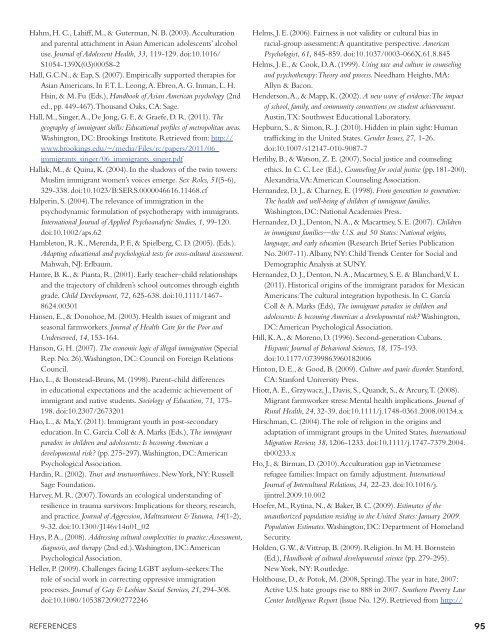Crossroads: The Psychology of Immigration in the New Century
Crossroads: The Psychology of Immigration in the New Century
Crossroads: The Psychology of Immigration in the New Century
Create successful ePaper yourself
Turn your PDF publications into a flip-book with our unique Google optimized e-Paper software.
Hahm, H. C., Lahiff, M., & Guterman, N. B. (2003). Acculturation<br />
and parental attachment <strong>in</strong> Asian American adolescents’ alcohol<br />
use. Journal <strong>of</strong> Adolescent Health, 33, 119-129. doi:10.1016/<br />
S1054-139X(03)00058-2<br />
Hall, G.C.N., & Eap, S. (2007). Empirically supported <strong>the</strong>rapies for<br />
Asian Americans. In F. T. L. Leong, A. Ebreo, A. G. Inman, L. H.<br />
Hs<strong>in</strong>, & M. Fu (Eds.), Handbook <strong>of</strong> Asian American psychology (2nd<br />
ed., pp. 449-467). Thousand Oaks, CA: Sage.<br />
Hall, M., S<strong>in</strong>ger, A., De Jong, G. F., & Graefe, D. R. (2011). <strong>The</strong><br />
geography <strong>of</strong> immigrant skills: Educational pr<strong>of</strong>iles <strong>of</strong> metropolitan areas.<br />
Wash<strong>in</strong>gton, DC: Brook<strong>in</strong>gs Institute. Retrieved from: http://<br />
www.brook<strong>in</strong>gs.edu/~/media/Files/rc/papers/2011/06_<br />
immigrants_s<strong>in</strong>ger/06_immigrants_s<strong>in</strong>ger.pdf<br />
Hallak, M., & Qu<strong>in</strong>a, K. (2004). In <strong>the</strong> shadows <strong>of</strong> <strong>the</strong> tw<strong>in</strong> towers:<br />
Muslim immigrant women’s voices emerge. Sex Roles, 51(5-6),<br />
329-338. doi:10.1023/B:SERS.0000046616.11468.cf<br />
Halper<strong>in</strong>, S. (2004). <strong>The</strong> relevance <strong>of</strong> immigration <strong>in</strong> <strong>the</strong><br />
psychodynamic formulation <strong>of</strong> psycho<strong>the</strong>rapy with immigrants.<br />
International Journal <strong>of</strong> Applied Psychoanalytic Studies, 1, 99-120.<br />
doi:10.1002/aps.62<br />
Hambleton, R. K., Merenda, P. F., & Spielberg, C. D. (2005). (Eds.).<br />
Adapt<strong>in</strong>g educational and psychological tests for cross-cultural assessment.<br />
Mahwah, NJ: Erlbaum.<br />
Hamre, B. K., & Pianta, R. (2001). Early teacher–child relationships<br />
and <strong>the</strong> trajectory <strong>of</strong> children’s school outcomes through eighth<br />
grade. Child Development, 72, 625-638. doi:10.1111/1467-<br />
8624.00301<br />
Hansen, E., & Donohoe, M. (2003). Health issues <strong>of</strong> migrant and<br />
seasonal farmworkers. Journal <strong>of</strong> Health Care for <strong>the</strong> Poor and<br />
Underserved, 14, 153-164.<br />
Hanson, G. H. (2007). <strong>The</strong> economic logic <strong>of</strong> illegal immigration (Special<br />
Rep. No. 26). Wash<strong>in</strong>gton, DC: Council on Foreign Relations<br />
Council.<br />
Hao, L., & Bonstead-Bruns, M. (1998). Parent-child differences<br />
<strong>in</strong> educational expectations and <strong>the</strong> academic achievement <strong>of</strong><br />
immigrant and native students. Sociology <strong>of</strong> Education, 71, 175-<br />
198. doi:10.2307/2673201<br />
Hao, L., & Ma, Y. (2011). Immigrant youth <strong>in</strong> post-secondary<br />
education. In C. García Coll & A. Marks (Eds.), <strong>The</strong> immigrant<br />
paradox <strong>in</strong> children and adolescents: Is becom<strong>in</strong>g American a<br />
developmental risk? (pp. 275-297). Wash<strong>in</strong>gton, DC: American<br />
Psychological Association.<br />
Hard<strong>in</strong>, R. (2002). Trust and trustworth<strong>in</strong>ess. <strong>New</strong> York, NY: Russell<br />
Sage Foundation.<br />
Harvey, M. R. (2007). Towards an ecological understand<strong>in</strong>g <strong>of</strong><br />
resilience <strong>in</strong> trauma survivors: Implications for <strong>the</strong>ory, research,<br />
and practice. Journal <strong>of</strong> Aggression, Maltreatment & Trauma, 14(1-2),<br />
9-32. doi:10.1300/J146v14n01_02<br />
Hays, P. A., (2008). Address<strong>in</strong>g cultural complexities <strong>in</strong> practice: Assessment,<br />
diagnosis, and <strong>the</strong>rapy (2nd ed.). Wash<strong>in</strong>gton, DC: American<br />
Psychological Association.<br />
Heller, P. (2009). Challenges fac<strong>in</strong>g LGBT asylum-seekers: <strong>The</strong><br />
role <strong>of</strong> social work <strong>in</strong> correct<strong>in</strong>g oppressive immigration<br />
processes. Journal <strong>of</strong> Gay & Lesbian Social Services, 21, 294-308.<br />
doi:10.1080/10538720902772246<br />
References<br />
Helms, J. E. (2006). Fairness is not validity or cultural bias <strong>in</strong><br />
racial-group assessment: A quantitative perspective. American<br />
Psychologist, 61, 845-859. doi:10.1037/0003-066X.61.8.845<br />
Helms, J. E., & Cook, D. A. (1999). Us<strong>in</strong>g race and culture <strong>in</strong> counsel<strong>in</strong>g<br />
and psycho<strong>the</strong>rapy: <strong>The</strong>ory and process. Needham Heights, MA:<br />
Allyn & Bacon.<br />
Henderson, A., & Mapp, K. (2002). A new wave <strong>of</strong> evidence: <strong>The</strong> impact<br />
<strong>of</strong> school, family, and community connections on student achievement.<br />
Aust<strong>in</strong>, TX: Southwest Educational Laboratory.<br />
Hepburn, S., & Simon, R. J. (2010). Hidden <strong>in</strong> pla<strong>in</strong> sight: Human<br />
traffick<strong>in</strong>g <strong>in</strong> <strong>the</strong> United States. Gender Issues, 27, 1-26.<br />
doi:10.1007/s12147-010-9087-7<br />
Herlihy, B., & Watson, Z. E. (2007). Social justice and counsel<strong>in</strong>g<br />
ethics. In C. C. Lee (Ed.), Counsel<strong>in</strong>g for social justice (pp. 181-200).<br />
Alexandria, VA: American Counsel<strong>in</strong>g Association.<br />
Hernandez, D. J., & Charney, E. (1998). From generation to generation:<br />
<strong>The</strong> health and well-be<strong>in</strong>g <strong>of</strong> children <strong>of</strong> immigrant families.<br />
Wash<strong>in</strong>gton, DC: National Academies Press.<br />
Hernandez, D. J., Denton, N. A., & Macartney, S. E. (2007). Children<br />
<strong>in</strong> immigrant families—<strong>the</strong> U.S. and 50 States: National orig<strong>in</strong>s,<br />
language, and early education (Research Brief Series Publication<br />
No. 2007-11). Albany, NY: Child Trends Center for Social and<br />
Demographic Analysis at SUNY.<br />
Hernandez, D. J., Denton, N. A., Macartney, S. E. & Blanchard, V. L.<br />
(2011). Historical orig<strong>in</strong>s <strong>of</strong> <strong>the</strong> immigrant paradox for Mexican<br />
Americans: <strong>The</strong> cultural <strong>in</strong>tegration hypo<strong>the</strong>sis. In C. García<br />
Coll & A. Marks (Eds), <strong>The</strong> immigrant paradox <strong>in</strong> children and<br />
adolescents: Is becom<strong>in</strong>g American a developmental risk? Wash<strong>in</strong>gton,<br />
DC: American Psychological Association.<br />
Hill, K. A., & Moreno, D. (1996). Second-generation Cubans.<br />
Hispanic Journal <strong>of</strong> Behavioral Sciences, 18, 175-193.<br />
doi:10.1177/07399863960182006<br />
H<strong>in</strong>ton, D. E., & Good, B. (2009). Culture and panic disorder. Stanford,<br />
CA: Stanford University Press.<br />
Hiott, A. E., Grzywacz, J., Davis, S., Quandt, S., & Arcury, T. (2008).<br />
Migrant farmworker stress: Mental health implications. Journal <strong>of</strong><br />
Rural Health, 24, 32-39. doi:10.1111/j.1748-0361.2008.00134.x<br />
Hirschman, C. (2004). <strong>The</strong> role <strong>of</strong> religion <strong>in</strong> <strong>the</strong> orig<strong>in</strong>s and<br />
adaptation <strong>of</strong> immigrant groups <strong>in</strong> <strong>the</strong> United States. International<br />
Migration Review, 38, 1206-1233. doi:10.1111/j.1747-7379.2004.<br />
tb00233.x<br />
Ho, J., & Birman, D. (2010). Acculturation gap <strong>in</strong> Vietnamese<br />
refugee families: Impact on family adjustment. International<br />
Journal <strong>of</strong> Intercultural Relations, 34, 22-23. doi:10.1016/j.<br />
ij<strong>in</strong>trel.2009.10.002<br />
Hoefer, M., Ryt<strong>in</strong>a, N., & Baker, B. C. (2009). Estimates <strong>of</strong> <strong>the</strong><br />
unauthorized population resid<strong>in</strong>g <strong>in</strong> <strong>the</strong> United States: January 2009.<br />
Population Estimates. Wash<strong>in</strong>gton, DC: Department <strong>of</strong> Homeland<br />
Security.<br />
Holden, G. W., & Vittrup, B. (2009). Religion. In M. H. Bornste<strong>in</strong><br />
(Ed.), Handbook <strong>of</strong> cultural developmental science (pp. 279-295).<br />
<strong>New</strong> York, NY: Routledge.<br />
Holthouse, D., & Potok, M. (2008, Spr<strong>in</strong>g). <strong>The</strong> year <strong>in</strong> hate, 2007:<br />
Active U.S. hate groups rise to 888 <strong>in</strong> 2007. Sou<strong>the</strong>rn Poverty Law<br />
Center Intelligence Report (Issue No. 129). Retrieved from http://<br />
95
















